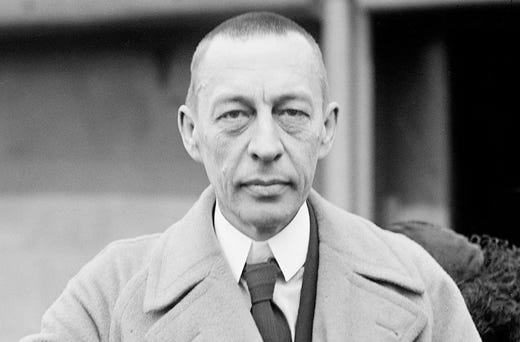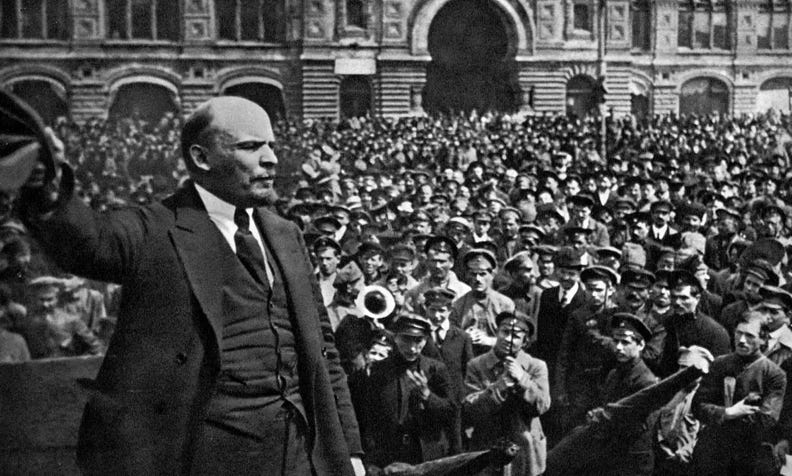
Sergei Rachmaninov
(1873-1943)
World War I was a trial for Rachmaninoff and his countrymen, but his most severe personal adversity came when the 1917 Revolution smashed Russia’s aristocratic society — the only world he had ever known. He was forced to flee his beloved country for America and he pined for his homeland the rest of his life. He did his best to keep the old language, food, customs and holidays alive in his own household, “but it was at best synthetic,” wrote American musicologist David Ewen. “Away from Russia, which he could never hope to see again, he always felt lonely and sad, a stranger even in lands that were ready to be hospitable to him. His homesickness assumed the character of a disease as the years passed, and one symptom of that disease was an unshakable melancholy.” By 1940, when he composed the Symphonic Dances, he was filled with worry over his daughter Tatiana, who was trapped in France by the German invasion (he never saw her again), and had been weakened by a minor operation in May. Still, he felt the need to compose for the first time since the Third Symphony of 1936. The three Symphonic Dances were written quickly at his summer retreat on Long Island Sound, an idyllic setting for creative work, where he had a studio by the water in which to work in seclusion, lovely gardens for walking, and easy access to a ride in his new cabin cruiser, one of his favorite amusements. Still, it was the man and not the setting that was expressed in this music. “I try to make music speak directly and simply that which is in my heart at the time I am composing,” he once told an interviewer. “If there is love there, or bitterness, or sadness, or religion, these moods become part of my music, and it becomes either beautiful or bitter or sad or religious.”

The Bolshevik Revolution in Russia initiated Rachmaninov’s self-imposed exile from his native land. He would never return.
It is nostalgic sadness that permeates the works of Rachmaninoff’s later years. Like a grim marker, the ancient chant Dies Irae (“Day of Wrath”) from the Roman Catholic Requiem Mass for the Dead courses through the Paganini Rhapsody (1934), the Second (1908) and Third (1936) Symphonies and the Symphonic Dances (1940). The Symphonic Dances were his last important creation, coming less than three years before his death from cancer at age 70. There is nothing morbid about them, however. They breathe a spirit of dark determination against a world of trial, a hard-fought musical affirmation of the underlying resiliency of life. Received with little enthusiasm when they were new, the Symphonic Dances have come to be regarded as among the finest of Rachmaninoff’s works.
PROGRAM NOTES
Symphonic Dances Opus 45
Genre: Symphonic; Country: Russia; Period: Late Romantic
Completed in 1940; Premiered on January 4, 1941
with Philadelphia Orchestra, conducted by Eugene Ormandy

The first of the Symphonic Dances, in a large three-part form (A–B–A), is spun from a tiny three-note descending motive heard at the beginning that serves as the germ for much of the opening section’s thematic material. The middle portion is given over to a folk-like melody initiated by the alto saxophone, a relatively rare visitor to the symphony orchestra, and which was suggested to Rachmaninov by American composer Robert Russell Bennett.The return of the opening section, with its distinctive falling motive, rounds out the first movement. The first dance ends with a modified quotation from his unfortunate First Symphony (1897), here nostalgically rendered in a major key. The waltz of the second movement is more rugged and deeply expressive than the Viennese variety, and possesses the quality of inconsolable pathos that gives so much of Rachmaninoff’s music its sharply defined personality. This movement began life with the subtitle “Dusk”. The finale begins with a sighing introduction for the winds, which leads into a section in quicker tempo whose vital rhythms may have been influenced by the syncopations of American jazz. Soon after this faster section begins, the chimes play a pattern reminiscent of the opening phrase of the Dies Irae. The sighing measures recur and are considerably extended, acquiring new thematic material but remaining unaltered in mood. When the fast, jazz-inspired music returns, its thematic relationship with the Dies Irae is strengthened. The movement accumulates an almost visceral rhythmic energy as it progresses, virtually exploding into the last pages, a coda based on an ancient Russian Orthodox chant (which he had earlier used in his All-Night Vigil Service of 1915) whose entry Rachmaninoff noted by inscribing “Alliluya” in the score. Was a specific message intended here? As the Alliluya succeeds the Dies Irae, did the composer mean to show that the Church conquers death? Optimism, sadness? Rachmaninoff was silent on the matter, except to say, “A composer always has his own ideas of his works, but I do not believe he ever should reveal them. Each listener should find his own meaning in the music.”

Conductor Eugene Ormandy, with the Philadelphia Orchestra